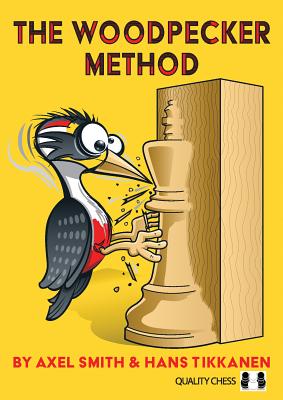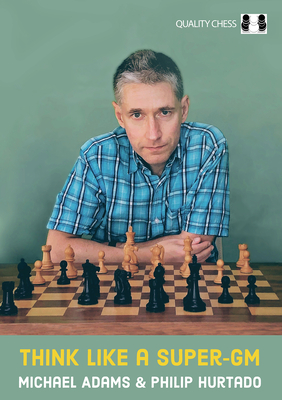


The Woodpecker Method is the name given by Axel Smith to a training system developed by his compatriot and co-author Hans Tikkanen. After training with his method in 2010, Tikkanen achieved three GM norms within a seven-week period.
The quick explanation of the Woodpecker Method is that you need to solve a large number of puzzles in a row; then solve the same puzzles again and again, only faster. It's not a lazy shortcut to success - hard work is required. But the reward can be re-programming your unconscious mind. Benefits include sharper tactical vision, fewer blunders, better play when in time trouble and improved intuition.
This book contains everything you need to carry out your own Woodpecker training. Smith and Tikkanen explain how to get the maximum benefit from the method, before presenting over 1100 puzzles and solutions, all of which have been checked and double-checked for accuracy and suitability.




Chess players are offered a complete fighting repertoire for White against the Sicilian with 1.e4 c5 2.d4 cxd4 3.c3. The Morra Gambit is a popular weapon at club level, but can it be effective at grandmaster level? Marc Esserman believes so and he has 2700-rated scalps to back up his view.
Esserman is the world's leading expert on the Morra Gambit and he shares all his secrets and many novelties in a lively witty style. The Morra leads to exciting gambit play, so some players decline the offer with 3...Nf6 - Esserman also shows how White can attack this cautious defense.
Don't be afraid of the Sicilian - unleash Mayhem in the Morra!


Artur Yusupov's complete course of chess training stretches to nine volumes, guiding the reader towards a higher chess understanding using carefully selected positions and advice. To make sure that this new knowledge sticks, it is then tested by a selection of puzzles.
The course is structured in three series with three levels. The Fundamentals level is the easiest one, Beyond the Basics is more challenging, and Mastery is quite difficult, even for stronger players.
The various topics - Tactics, Strategy, Positional Play, Endgames, Calculating Variations, and Openings - are spread evenly across the nine volumes, giving readers the chance to improve every area as they work through the books.
This book is the first volume at the Fundamentals level.
The Build Up Your Chess series won the prestigious Boleslavsky Medal from FIDE (the World Chess Federation) as the best instructional chess books in the world.

Have there been times during a chess game when you have calculated a position for half an hour, only to find out that most of what you were thinking about was of little use? If you have not, maybe the only way to improve your calculation is to upgrade your processor. But if you are human, then this book will offer you practical advice and an effective training plan to think differently and make decisions far more efficiently. In Calculation thinking methods such as Candidates, Combinations, Prophylaxis, Comparison, Elimination, Intermediate Moves, Imagination and Traps are explained to the reader, and ownership of them is offered through a carefully selected series of exercises.
There is no shortcut to the grandmaster title, but there is a well-known route that many people have walked over the years. Jacob offers to guide you on part of this journey and I hope you will take him up on the offer. From the foreword by Boris Gelfand



Positional Decision Making in Chess offers a rare look into the mind of a top grandmaster. In his efforts to explain his way of thinking, Boris Gelfand focuses on such topics as the squeeze, space advantage, the transformation of pawn structures and the transformation of advantages. Based on examples from his own games and those of his hero, Akiba Rubinstein, Gelfand explains how he thinks during the game.

In Strategic Play Jacob Aagaard digs deep into the most complex area of chess thinking. The games and exercises in this book transcend regular chess skills, such as pattern recognition, calculation and positional analysis. Building on the two previous books in the Grandmaster Preparation series, this book challenges the reader to explore the complexities of chess, offering clarity and understanding through Aagaard's straightforward approach.
The Grandmaster Preparation series is aimed at ambitious players.

Think Like a Super-GM is a unique collaboration combining the chess insights of an elite grandmaster with a scientific investigation into thinking at the chess board.
40 chess puzzles were shown to a panel of players ranging from occasional club players up to Super-GM and co-author Michael Adams. Researcher Philip Hurtado recorded not only the moves chosen, but also the detailed thought processes of every player in order to shed light on the mystery as to what exactly defines superior chess strength.
This book offers a unique opportunity for readers to not only solve the puzzles, but also compare their thinking to that of club players, strong amateurs, IMs, GMs and Michael Adams himself. With an additional Bonus Puzzle section and a fascinating Eyetracker experiment showing where different players focused their attention on the board, this is a chess improvement book like no other.


Any man in the street knows how to increase his physical strength, but among most chess players confusion reigns when it comes to improving their playing strength. Axel Smith's training methods have guided his friends, teammates and pupils to grandmaster norms and titles. Hard work will be required, but Axel Smith knows how you can Pump Up Your Rating.
Every area of chess is covered - opening preparation, through middlegame play, to endgame technique. Smith delves into both the technical and psychological sides of chess, and shows how best to practise and improve.

Artur Yusupov's complete course of chess training stretches to nine volumes, guiding the reader towards a higher chess understanding using carefully selected positions and advice. To make sure that this new knowledge sticks, it is then tested by a selection of puzzles.
The course is structured in three series with three levels. The Fundamentals level is the easiest one, Beyond the Basics is more challenging, and Mastery is quite difficult, even for stronger players.
The various topics - Tactics, Strategy, Positional Play, Endgames, Calculating Variations, and Openings - are spread evenly across the nine volumes, giving readers the chance to improve every area as they work through the books.
This book is the third volume at the Fundamentals level.


A mastery of tactics is essential to a competitive chess player, and the original Advanced Chess Tactics became an instant classic in this field. This book is absolutely superb. For serious players... this volume will provide a wonderful breadth of study material and act as a workbook to advance your skills and understanding of this important topic... was Carsten Hansen's comment when awarding the book 6/6 stars.
This new edition benefits from various analytical tweaks, plus an entirely new chapter dedicated to attacking in the French Defense, an opening which the author knows better than almost anyone, having played it for most of his career. Readers are sure to find this an invaluable addition to the original chapters, which remain usefully categorized by opening or common pawn structure.

Jacob Aagaard describes his chess improvement philosophy, developed over more than twenty years of thinking about one question: How do we make better decisions at the chess board?
As the final volume in the award-winning Grandmaster Preparation series, this book unifies the concepts of the previous five books and delves into such topics as:
Chess psychology
The four types of decisions we take at the board
How to play simple positions
What is calculation?
How to analyse your games
And many more
Thinking Inside the Box is the ultimate self-improvement guide, written for amateurs as well as world-class players.